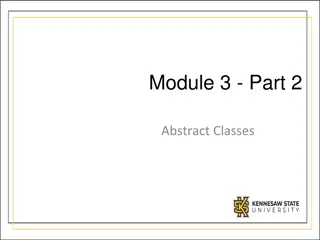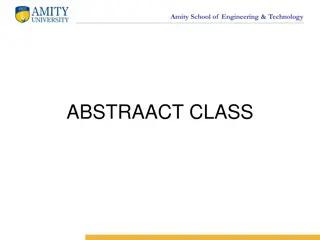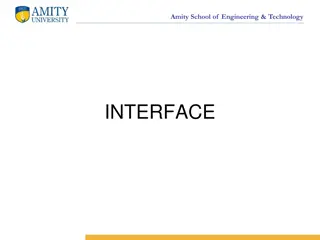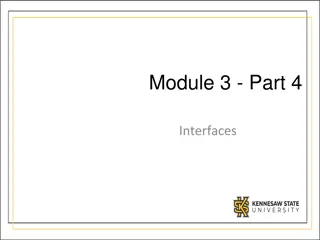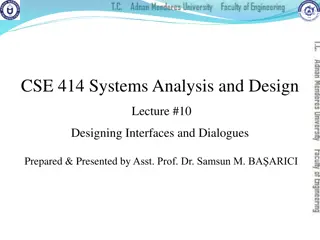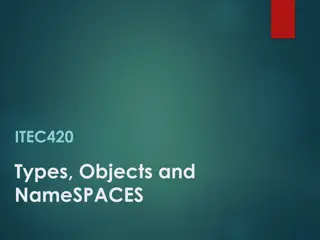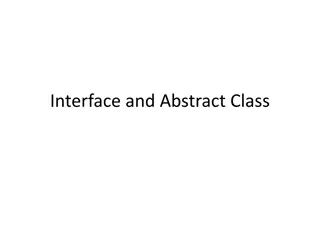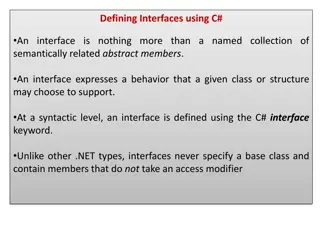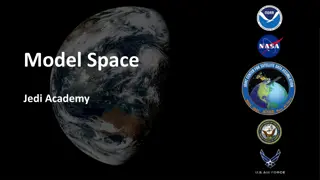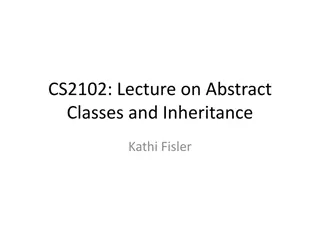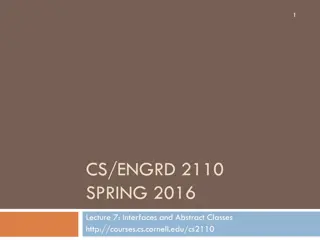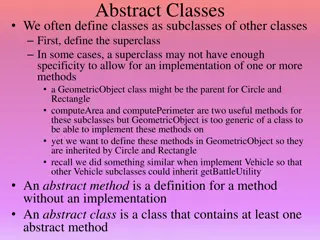Understanding Interfaces and Abstract Classes in CS/ENGRD.2110.FALL.2016
This content covers the concepts of interfaces and abstract classes in a computer science/engineering lecture, discussing the implementation of shapes, method overriding, and the role of abstract classes in preventing instantiation. Various challenges and solutions related to abstract classes and methods are explored through demos and examples.
Download Presentation

Please find below an Image/Link to download the presentation.
The content on the website is provided AS IS for your information and personal use only. It may not be sold, licensed, or shared on other websites without obtaining consent from the author. Download presentation by click this link. If you encounter any issues during the download, it is possible that the publisher has removed the file from their server.
E N D
Presentation Transcript
1 CS/ENGRD 2110 FALL 2016 Lecture 7: Interfaces and Abstract Classes http://courses.cs.cornell.edu/cs2110
Announcements 2 Attendance for this week s recitation is mandatory! A2 is due Today Get started on A3 a method every other day
A Little Geometry! Abstract Classes Shape x ____ y ____ Square Circle Triangle area() size ____ area() radius __5__ area() base____ height ____
Demo 1: Complete this function Abstract Classes /** Return the sum of the areas of * the shapes in s */ static double sumAreas(Shape[] s) { } 1. Operator instanceof and casting are required 2. Adding new Shape subclasses breaks sumAreas
A Partial Solution: Abstract Classes Add method area to class Shape: public double area() { return 0; } public double area() { throw new RuntimeException( area not overridden ); }
Problems not solved Abstract Classes 1. What is a Shape that isn t a Circle, Square, Triangle, etc? What is only a shape, nothing more specific? a.Shapes= new Shape(...); Should be disallowed 2. What if a subclass doesn t override area()? a. Can t force the subclass to override it! b. Incorrect value returned or exception thrown.
Solution: Abstract classes Abstract Classes Abstract class Means that it can t be instantiated. new Shape() illegal public abstract class Shape { public double area() { return 0; } }
Solution: Abstract methods Abstract Classes Can also have implemented methods public abstract class Shape { public abstract double area(); Place abstract method only in abstract class. } Abstract method Subclass must override. Semicolon instead of body.
Demo 2: A better solution Abstract Classes We modify class Shape to be abstract and make area() an abstract method. Abstract class prevents instantiation of class Shape Abstract method forces all subclasses to override area()
Abstract Classes, Abstract Methods Abstract Classes 1. Cannot instantiate an object of an abstract class. (Cannot use new-expression) 2. A subclass must override abstract methods.
Problem Interfaces Where is the best place to implement whistle()? Animal Mammal Bird Whistler Human Dog Parrot
No multiple inheritance in Java! Interfaces class Whistler { void breathe() { } } class Animal { void breathe() { } } class Human extends Animal, Whistler { } new Human().breathe(); Which breathe() should java run in class Human?
Why not make it fully abstract? Interfaces class abstract Whistler { abstract void breathe(); } class abstract Animal { abstract void breathe(); } class Human extends Animal, Whistler { } Java doesn t allow this, even though it would work. Instead, Java has another construct for this purpose, the interface
Solution: Interfaces Interfaces methods are automatically public and abstract publicinterface Whistler { void whistle(); int MEANING_OF_LIFE= 42; } fields are automatically public, static, and final (i.e. constants) class Human extends Mammal implements Whistler { } Must implement all methods in the implemented interfaces
Multiple interfaces Interfaces Classes can implement several interfaces! publicinterface Singer { void singTo(Human h); } They must implement all the methods in those interfaces they implement. class Human extends Mammal implements Whistler, Singer { } Must implement singTo(Human h) and whistle()
Solution: Interfaces Interfaces Interface Whistler offers promised functionality to classes Human and Parrot! Animal Mammal Bird Whistler Human Dog Parrot
Casting to an interface Interfaces Human h= new Human(); Object o= (Object) h; Animal a= (Animal) h; Mammal m= (Mammal) h; Object Animal Singer s= (Singer) h; Whistler w= (Whistler) h; Whistler Mammal Singer All point to the same memory address! Human
Casting to an interface Interfaces Human h= new Human(); Object o= h; Animal a= h; Mammal m= h; Singer s= h; Whistler w= h; Object Automatic up-cast Animal Whistler Mammal Singer Forced down-cast Human
Casting up to an interface automatically Interfaces class Human implements Whistler { void listenTo(Whistler w) {...} } Human h = new Human(...); Human h1= new Human(...); h.listenTo(h1); Object Animal Whistler Mammal Arg h1 of the call has type Human. Its value is being stored in w, which is of type Whistler. Java does an upward cast automatically. It costs no time; it is just a matter of perception. Human
Demo 3: Implement Comparable<T> Implement interface Comparable in class Shape: public interface Comparable<T> { /** = a negative integer if this object < c, = 0 if this object = c, = a positive integer if this object > c. Throw a ClassCastException if c can t be cast to the class of this object. */ int compareTo(T c); }
Shape implements Comparable<T> public class Shape implements Comparable<Shape> { ... /** */ public int compareTo(Shape s) { double diff= area() - s.area(); return (diff == 0 ? 0 : (diff < 0 ? -1 : +1)); } }
Beauty of interfaces Arrays.sort sorts an array of any class C, as long as C implements interface Comparable<T> without needing to know any implementation details of the class. Classes that implement Comparable: Boolean Byte Double Integer String BigDecimal BigInteger Calendar Time Timestamp and 100 others
String sorting Arrays.sort(Object[] b)sorts an array of any class C, as long as C implements interface Comparable<T>. String implements Comparable, so you can write String[] strings= ...; ... Arrays.sort(strings); During the sorting, when comparing elements, a String s compareTo function is used
And Shape sorting, too! Arrays.sort(Object[] b) sorts an array of any class C, as long as C implements interface Comparable<T>. Shape implements Comparable, so you can write Shape[] shapes= ...; ... Arrays.sort(shapes); During the sorting, when comparing elements, a Shape s compareTo function is used
Abstract Classes vs. Interfaces Abstract class represents something Sharing common code between subclasses Interface is what something can do A contract to fulfill Software engineering purpose Similarities: Can t instantiate Must implement abstract methods Later we ll use interfaces to define abstract data types (e.g. List, Set, Stack, Queue, etc)


